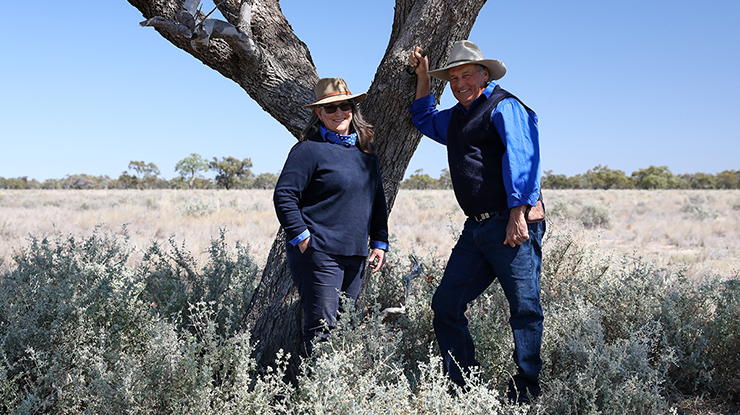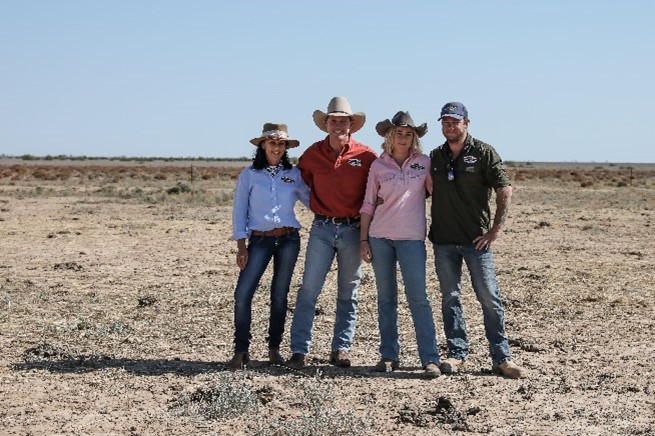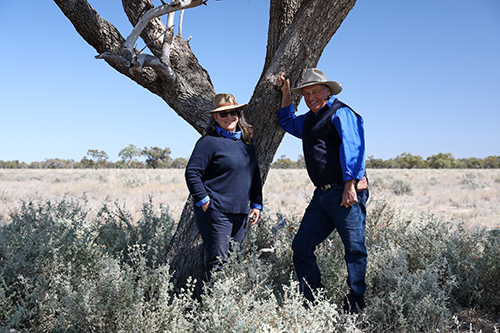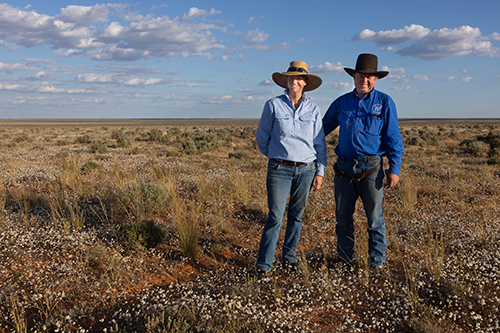 Julie and Glenn Humbert, ‘Gurrawarra’, Bourke NSW
Julie and Glenn Humbert, ‘Gurrawarra’, Bourke NSW
Striking the balance of strategic stock management
Managing livestock in the variable environment of the NSW rangelands presents unique challenges for producers. One of the greatest hurdles is making strategic decisions about how and when to destock, especially in the lead-up to dry periods.
The Rangelands Living Skin (RLS) project – led by the NSW Department of Primary Industries (DPI) and funded by MLA – maps how the on-property strategies of producers benefit soil, plants, animals and people.
Here, several of the core RLS producers – Graham and Cathy Finlayson, Glenn and Julie Humbert, and Angus and Kelly Whyte – share how they approach strategic stock management as a critical part of maintaining landscape health and business profitability.
Tools to counter the challenges
Strategic stock management is the process of matching the enterprise stocking rate to the carrying capacity of the land. Carrying capacity is based on the available feed, ground cover, condition of the landscape, and seasonal conditions. While producers can’t control the rain, they do have control over how they respond to the conditions in front of them.
Dry periods are a natural part of the Australian landscape, but maintaining landscape integrity through a dry period ensures it can flourish when the rain returns.
The challenge is, the onset of a dry period is often gradual and deceptive. In the rangelands, rain can arrive at any time and produce forage growth, meaning flexible decision making around the production system is important. The uncertainty of market and weather conditions requires daily decision-making to manage possible scenarios.
The RLS core producers manage this uncertainty through daily and weekly monitoring of the landscape and rain conditions, using grazing charts and monitoring the number of feed days ahead. In doing so, they help to maintain the condition of both stock and land and to manage the profitability and sustainability of the business.
“We benchmark carrying capacity against grazing charts and rolling rainfalls, which have been on a steady decline since October 2022 – this helps you to know where you sit every day,” Glenn said.
“As the producer you know once you start exceeding the benchmark, you go into an overdraft as you start to eat tomorrow’s feed. As a result, in dry periods we are not running on the perception that we are in tough times, but well and truly normal as part of the cycle.
“You might choose to push over the benchmark knowing that you have ewes with lambs, knowing that lambs will be sold, so stocking rate would be halved at that point.”
Graham and Cathy take the approach that livestock numbers are only one component – they must be looked at in conjunction with the previous 12 months rainfall and in relation to actual feed ahead.
They match the class of livestock to feed on hand, and in some areas match breeding to the seasonal cycles.
Destocking options
Selling stock early when in good condition is a strategic business decision that can reduce risk and ‘lock in’ a return. An early sale provides greater certainty over financial returns and available resources and creates options for other decisions to be made.
However, as Graham recognises, there’s a lot to consider when it comes to destocking.
“Destocking is a simple enough strategy but not easy to do at all,” he said. “So many other factors come into play, from sudden market shifts, debt load of the business as well as appetite for risk.”
Early decision-making is key
As part of a strategic stock management approach, reducing stock numbers – whether by selling, taking advantage of agistment opportunities, to moving stock to other owned/leased properties – can be a sound strategy for landscape preservation, but deciding when to do so is the challenge.
Making the decision to destock early can be difficult, but it does buy a business additional time.
Success in this stock management strategy typically involves moving before market conditions deteriorate to maintain sufficient ground cover as a dry spell kicks in. Delaying the decision to destock can require a more drastic rebalancing of stocking rate to carrying capacity in the future, and leaving the decision too late may mean a producer cannot sell stock at a reasonable price. While this creates further challenges, delaying decisions is still unfavourable.
Mindset is a key factor for each core producer in successfully managing stock numbers.
For example, Angus and Kelly Whyte approach dry periods as a normal part of the cycle which needs to be managed, rather than having a ‘tough times’ mindset which might accompany drought. This way, they can better manage their relationship to the changing conditions.
They aim to destock/restock in chunks, of about 10–15% of total stock numbers at a time. They aim to always have the next truckload of stock to sell identified, which helps with decision making and so they can give their stock agent plenty of notice so they can market them.
“An important help to destocking decisions is to have diversity of livestock, species and class, the more diversity can make decisions easier,” Angus said.
He has this example of how diversity creates more options.
“An example may be that the feed is only suited to dry stock due to low quality, so you have choices to destock those lambing/calving or add some supplements. Usually the drier the area, the smaller the percentage of core breeders you can retain, so in a 500mm rainfall zone you might set a number at 50% of total DSEs (dry sheep equivalent). In our area, a 250mm rainfall zone, the number might be 20%. This doesn’t mean we don’t have many breeding stock – we have many breeding stock which aren’t our preferred genetics, so they are easy to sell.”
Remove the emotion
Another insight from the RLS project is how having a plan for approaching strategic stock management can help remove emotions from the decision-making process.
This plan can be informed by how you consider economic outcomes, and the debt-load and risk-appetite in the business.
For example, when a business is focused on achieving gross margins rather than gross profits, selling stock early can reduce risk and provide greater certainty of the gross margin for that season.
If the focus is on gross profits, the temptation to wait for rain or a better stock price may influence decisions. Remaining focused on gross margins and having a clear plan about when to act can reduce emotion-based decision-making.
Other options to reduce risk and manage uncertainty are destocking incrementally, short-term agistment on other properties, increasing stock diversity, and using feed substitutes to reduce grazing load on the landscape while maintaining animal health.
Managing genetics
Another consideration for decision-making is the genetic capital of an enterprise. Producers in the RLS project are developing livestock genetics adapted to the harsh rangeland conditions through breeding.
While destocking can set back years of work to build up this genetic capital, there are strategies available that the core producers have used to manage this. Retaining a portion of the genetic base is a goal, but the extent of stock retained can depend on the severity and duration of the dry spell. Being able to agist select stock on other properties can also help to manage the process.
Angus provides an example of how they take advantage of a ‘low market’.
“Selling in a low market also offers the opportunity to buy into a low market and this can be used as part of a herd replacement strategy,” he said.
“This strategy can be used in a few ways – you can sell down more stock than is required and replace to keep trading and be buying and selling in the same market, creating a margin. This also allows the opportunity to refocus your breeding objectives. In our situation, the 2017–2020 dry period refocused us on selecting for barer breach sheep, that combined with our white wool, reduces the need for mulesing and gives fly resistance.”
Destocking opportunities
Reducing stock numbers can provide opportunities for on-farm development. The RLS producers utilise intensive rotational grazing across smaller paddock sizes to stimulate plant growth, maintain higher ground cover and herbage mass to help retain soil moisture in the landscape.
Once a property is destocked, producers can use the opportunity to undertake strategic infrastructure or landscape improvements, such as further subdividing paddocks through increasing fencing and water, or undertaking mechanical interventions in the landscape, to set themselves up for when the rain comes again. In addition, the producers have found that installing additional quality fencing can reduce unwanted grazing pressure from feral goats and kangaroos.
“Once totally destocked, focusing on infrastructure improvements could be a consideration,” Graham said.
“This gets driven by economic priorities anyway, and at that point, our focus has usually been trying to make money elsewhere to make up the shortfall.”
Be prepared for the unexpected
RLS project lead, Sarah McDonald from NSW DPI, said thinking of a plan as ‘a way to get most things right most of the time’ can be helpful.
“While the RLS producers aim to consistently match stocking rate to carrying capacity, there can still be unexpected factors that make it challenging to follow the plan,” she said.
“Some producers experienced flood waters across parts of their properties earlier this year, meaning that some stock were inaccessible and unable to be sold, or that planned feed was out of reach or underwater.
“In addition, commodity prices have been low this year, unlike the last dry period, meaning that decisions are more likely to be led by emotion and the desire to ‘hold out’ for a better price.
“Nevertheless, having a plan provides a reference point against which decisions can be tested.”
Meet the producers

Graham and Cathy Finlayson (pictured with Harriet Finlayson and Chad Brash), ‘Bokhara Plains’, Brewarrina, NSW
Area: 9,300ha
Enterprise: Self-replacing cattle and sheep, running 5,000-10,000 dry sheep equivalent (DSE)
Soil: Semi-arid rangelands
Rainfall: 385mm
“Destocking is a simple enough strategy but not easy to do at all. So many other factors come into play, from sudden market shifts, debt load of the business as well as appetite for risk.”

Glenn and Julie Humbert, ‘Gurrawarra’, Bourke NSW
Area: 9,969ha
Enterprise: Self replacing merino flock, first cross store lamb production, agistment of cattle, run up to 6,000 DSE
Soil: Semi-arid rangelands
Rainfall: 370mm
“It’s important to note that we don’t ‘manage for drought,’ but are constantly managing the situation as it is.”

Angus and Kelly Whyte, ‘Wyndham Station’ and ‘Willow Point’, Wentworth, NSW
Area: 31,500ha
Enterprise: Trade and agistment cattle, Merino sheep and building a managed goat enterprise, run 2,000-14,000 DSE
Soil: Semi-arid rangelands
Rainfall: 250mm
“At Wyndham we like to destock/restock in chunks, about 10-15% of our total stock numbers at a time - the timing will never be right.”



